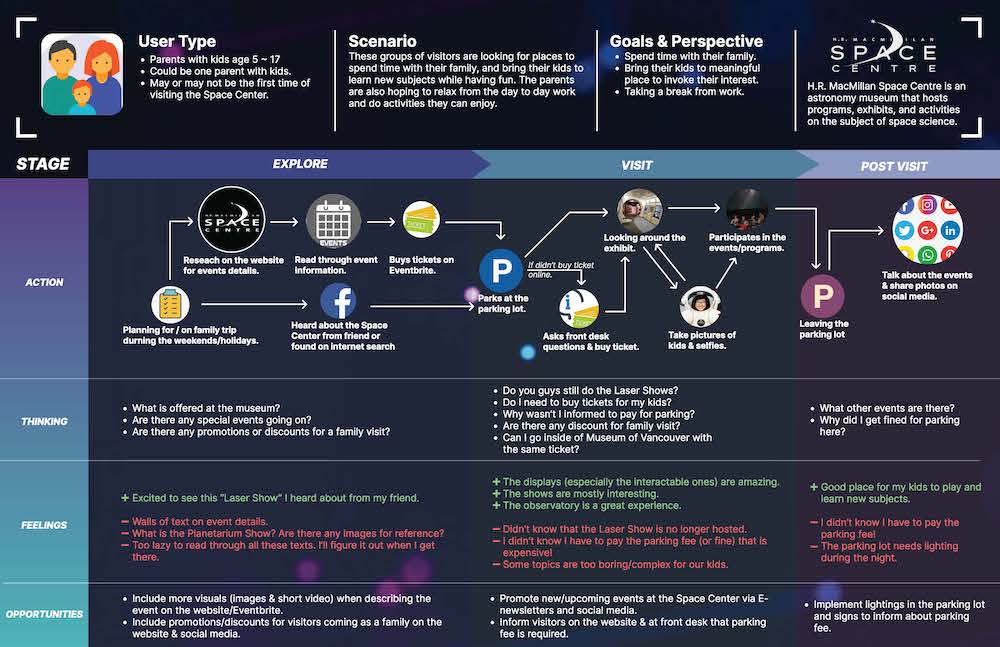

H.R. MacMillan Space Centre is a non-profit community resource that brings the wonders of space to Earth, while providing a personal sense of ongoing discovery.

Examine and understand the Space Center's target customer group and solve user frustrations based on research and design processes. Assisting the Space Centre in developing and improving its current projects by creating an interaction design that encourages visitors to explore space.

Gain insights through UX design research to create an interactive design for users
UX researcher, UX designer, project managing and
Conducted participatory workshops
15 weeks
5 Hours On-Site Observations
9 Informal Interviews
37 Online Reviewsest in space and believes that it is beneficial for their kids to learn about.
3D Animation/Modeling, Programmer, UX researcher, Graphic Design and Video Editor
Ethnographies were performed at the Space Centre along surveys. we visited the site as a team, explored the Space Cente as visitors. We took notes, and as a team we analyzed our data and insights from our ethnographic study and provided a thematic analysis of the data that helped us focus and determine potential design problems based on the data.

At this stage there was an ongoing process of analyzing and reframing our personas based on research. It was important to have an analytical understanding of the experiences facing potential users that adds to and built on ethnography and personas. It was important to communicate clearly and concisely the user journeys, based on insights and potential design problem.

Visitor journey mapping was a very important aspect, because it is a strategic approach to better understanding customer expectations and is crucial for optimizing the customer experience. We decided to focus on our persona, the parent.

User Journey Map: Based on parent persona, the scenario, goals and insights
We begin by brainstorming our idea based on design directions and journey maps, reframing our personas based on research based on design concepts that help solve user frustrations. At this stage there was an ongoing process of analyzing and reframing our personas based on research based on design concepts that help solve user frustrations. Three concepts and story boards/journey maps associated with the persona and each design solution.
Conducted a participatory design with stakeholders and potential visitors that we are designing for. The purpose of this workshop was to begin focusing down to specific areas of our design focus where we see potential opportunities for design. We asked 6 employees, Customer service Directors (Operations, Finance) Marketing team Focused on our user group thinking, telling stories, drawing and making things that dig into how they see these areas of focus and what issues and opportunities might exist there. The workshops were not design to exploring the viability or richness of an idea.

.jpg)

Virtual Workshop with participants from Space Centre (left) and end-users (middle). Survey from a team-member at the Space centre(right)
Implementing fun and meaningful on-site quiz games to decrease idle time between gallery tour and theater live shows at the H.R. MacMillan Space Centre.no. Our design argument is to bridge the gap between the user frustration and the Space centre needs that satisfies the parent persona and visitors in general gets ppl involved with the information displaced and test their knowledge
Focusing on figuring out the right problem to tackle is the core of this UX process. I constantly strive to concentrate on a user-centric approach through iterative sprints, from conducting research while being inclusive of the stakeholders in the design process. Whether it's facilitating workshops or getting hands-on, working collaboratively has allowed me to discover the most suitable principles for each project. When the project requires it, I can modify the UX process according to the given scope.
